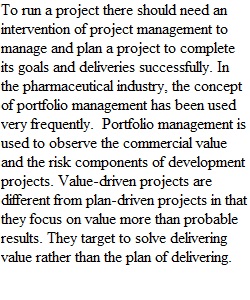


Q QSO 680 Milestone One Guidelines and Rubric Overview: For the final project in the course, you will analyze the case study Value-Driven Project and Portfolio Management in the Pharmaceutical Industry and additional course resources to create a program performance report for a hypothetical organization. The completion of this project will allow you to demonstrate your knowledge of program-level management and your ability to develop key executive reporting following standard frameworks. Prompt: In Module One, you wrote an overview of the case study you will be using for your final project. In this milestone, using the project charter template provided, you will now dig more deeply into the case study information to create a project charter, which gives you a high-level perspective of the project. A data set for this case study has also been provided for your benefit. You are expected to complete each section of the charter template. When you complete your final project program report, you will pull the information you need from your charter to complete your program report. For the project charter, specifically, the following critical elements must be addressed: I. Discuss the project purpose and background. Here you will provide the organization’s justification for taking on the project. II. Identify the project’s goals, objectives, and expectations. Be sure that your goals are measurable. III. Discuss the end product or service to be supplied. Here you will discuss the scope of the end product or service and the business need that the project will address. IV. Identify milestones/estimated deliverables. Note the relationship between the project deliverables and the project objectives. The deliverables should meet the objectives. V. Discuss the success criteria. How will “success” be measured? VI. Identify the high-level risks. How do the risks potentially impact the project? VII. Identify the key stakeholders. What is the role of each stakeholder in the project? VIII. Identify any assumptions, restrictions, and external dependencies. What are the assumptions on which decisions are being made? IX. Identify any customer responsibilities. Will the customer be doing any tasks or contributing any resources to the project? X. Complete a project category table allowing a high-level view of the project. XI. Specify a high-level budget. Guidelines for Submission: Your project charter must be submitted using the provided project charter template. Critical Elements Proficient (100%) Needs Improvement (75%) Not Evident (0%) Value Purpose and Background Discusses project purpose, background and justification Discusses project purpose, background, and justification but with gaps in detail and relevance Does not discuss project purpose, background, and justification 8.5 Goals, Objectives, and Expectations Identifies measurable goals, objectives, and expectations Identifies goals, objectives, and expectations but some or all are not measurable Does not identify measurable goals, objectives, and expectations 8.5 End Product or Service Discusses end product or services to be supplied Discusses end product or services to be supplied but with gaps in detail Does not discuss end product or services to be supplied 8.5 Deliverables Identifies major milestones and deliverables aligned with project objectives Identifies major milestones and deliverables, but they are not clearly aligned with project objectives Does not identify major milestones and deliverables 8.5 Success Criteria Identifies and discusses quantifiable success criteria Identifies and discusses success criteria but with gaps in detail and/or they are not quantifiable Does not identify and discuss success criteria 8.5 High-Level Risks Identifies high-level risks and potential impact Identifies high-level risks but with gaps in details of potential impact Does not identify high-level risks and potential impact 8.5 Key Stakeholders Identifies key stakeholders and their roles Identifies key stakeholders but with gaps in detail of roles Does not identify key stakeholders and their roles 8.5 Assumptions Identifies assumptions on which key decisions are based Identifies assumptions on which key decisions are based but with gaps in detail and/or logic Does not identify assumptions on which key decisions are based 8.5 Customer Responsibilities Identifies the customer responsibilities to the project Identifies the customer responsibilities to the project but with gaps in detail Does not identify the customer responsibilities to the project 8.5 Project Category Completes the project category table Works on the project category table but table is incomplete or illogical Does not complete the project category table 8.5 Budget Specifies a high-level budget Specifies a high-level budget but with gaps in detail and/or logic Does not specify a high-level budget 8.5 Articulation of Response Submission has no major errors related to citations, grammar, spelling, syntax, or organization Submission has major errors related to citations, grammar, spelling, syntax, or organization that negatively impact readability and articulation of main ideas Submission has critical errors related to citations, grammar, spelling, syntax, or organization that prevent understanding of ideas 6.5 Total 100%
View Related Questions